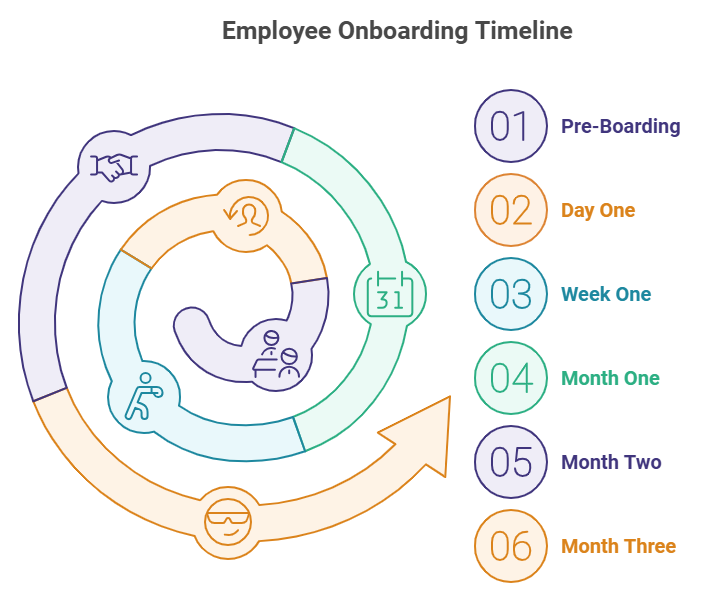
Employee onboarding is the procedure of formally incorporating new workers into your organization, making them feel accepted and entrenched in your company’s culture, and exposing them to the tools and teams with whom they will work. Giving your new hires a positive onboarding experience is an opportunity to make a good first impression and give a better experience in the employee lifecycle.
According to statistics for onboarding employees, the average new hire is expected to complete 54 activities during their onboarding process.
But how long does onboarding take? A day? A month? A year? This is what we will answer in this article.
Related articles:
How to Create a Successful Paperless Onboarding Process
11 Onboarding Best Practices You Need in 2024
How Long Should the Onboarding Process Last?
The most commonly accepted answer among the HR community is three to six months. 15% of companies continue onboarding after six months. But nearly 90% of employees decide whether to stay or go within that first six months.
According to some research, firms can improve job satisfaction by extending onboarding for the full first year of employment. Employees become more efficient, feel more at ease in their workplace, understand what to do when they have concerns, adapt to the business culture, and establish stronger employee relationships when a more complete onboarding program is implemented that lasts the entire first year.
Despite the fact that most HR professionals recognize the need for prolonged onboarding, recent polls revealed that major portions of hiring managers and Human resource professionals devote only about a month to onboarding new workers. Half of those surveys indicated that they spend little more than a week on onboarding. Pushing individuals through documentation and training in order for them to start working sooner may not be the best way to increase employee performance and contribution.
Employee Onboarding First 90 Days Timeline
Onboarding new employees, like any other complicated process, involves well-documented and methodical procedures. The following steps will provide a starting point for your process. Customize them with sub-steps appropriate to your business culture to create a one-of-a-kind onboarding experience that reflects your company’s organizational structure and increase the retention rates from the start.
Pre-Boarding (prior to start date)
The onboarding starts before the employee’s official start date. This is the time between the signing of the offer letter and their first day where the HR and manager are preparing for the arrival of the new employee. You will want to order necessary equipment, access badges and other materials the new hire may need to do during the first days of employment.
But this part of the process can also be personalized to address certain questions that new employees may have before arriving on their first day. For example, the pre-boarding phase can be used to provide the new employee with the logistical details of their first day, the office dress code if they will be working on site, provide an employee handbook and inform them of other company policies they should be aware of before starting.
Providing this information can help them arrive on-time, prepared and aware of what to expect when they show up on their first day. You can also use this time to get some paperwork out of the way so that they can focus on getting acclimated to their new work environment when they start.
Day One
The main goals of the first day should be setting expectations for the employee and giving them a clear idea of what their job will be like on a daily basis since the first day of employment. This can be about the employee orientation program to the mentorship process they will go through.
This day will look considerably different for remote employees than for those who report to a physical location on their first day. However, the plan is ultimately the same. You’ll want to include the following items in the first-day itinerary:
-
Meet with the employee to welcome them and give them an overview of the day.
-
An icebreaker or introduction to their co-workers to assimilate better to the work environment.
-
Hand out equipment (this may be done beforehand if the employee is remote).
-
Provide access to company apps, software, employee portals, email, etc.
-
Introduce the new hire to their points of contact in each department.
-
Finish up any outstanding paperwork.
-
Go over relevant payroll procedures, company benefits, time-off requests, and other applicable HR items.
-
Give them a tour of the office (if applicable).
-
Introduce the company values and mission and how they play a part in the employee’s day-to-day work life.
-
Schedule a 1:1 meeting with their manager to see how their first day went and address any concerns or questions they employee may have.
Week One
Typically, employees then go through a training period to get them up to speed and prepare them to make their early contributions to the team.
No matter what training method your organization uses, this first week is critical in terms of providing adequate support and communication, ensuring the employee feels comfortable in their new role. At the same time, you want to make sure you don’t overwhelm them with information so that they are able to absorb it in a manageable flow and be successful to every tasks they’re in charge of.
At the end of the first week, schedule another 1:1 meeting with their manager to make sure the employee is still comfortable, engaged and satisfied with their job and work environment. This is also a good opportunity to get feedback from the employee on the pace of their learning and whether they have all the resources they need for self efficacy.
Month One
After the first week and within the first month of the new job, the employee is starting to get to know their surroundings and familiarizing themselves with the company culture. They are exposed to the company’s values; the business processes and the way things operate.
At the end of the first month, you’ll want to do another check-in to see whether the employee has any issues or concerns about their role or work environment. At this point, you’ll also want to ask for them to give you feedback about the onboarding process and see if they have any suggestions as to how to improve the experience for future new hires at the company.
Lastly, in the first month, HR should check the employee’s first paycheck to ensure they are being paid accurately and that benefits have been activated properly.
Month Two
The second month on the job is all about the new employee building relationships with their team members and across different departments as well. As they build relationships, they begin to understand the company culture even better and how things get done in the organization.
During the second month-check the manager should discuss the employee’s experiences with their team as well as their performance. This discussion is not meant to be a performance review where the manager evaluates the employee’s job performance but should give the employee an opportunity to voice whether their role and experiences match their expectations.
Month Three
During the third month on the job, the employee should start to feel acclimated and confident in their role. At this point, they can autonomously run and finish a project or specific process from start to finish. This will start to introduce them to other aspects of the company such as opportunities to learn and how to use their skill set to contribute to the success of their team.
The idea is to allow new employees to feel that they have a future at the company and that they can see themselves succeeding there in the long-term. Providing them with a development plan and involving them in their own career progression is one way to do that.
The 90-Day Mark
At the 90-day mark, the new employee should be able to say that they made the right decision by accepting the offer at the company. Ashot Nanayan, CEO & Founder of Digital World Institute, explains, “Extending onboarding beyond the first 90 days with structured mentorship, quarterly goal-setting sessions and clear career-path roadmaps can boost new-hire retention by up to 25% and accelerate their time to full productivity.”
A check-in with their manager is also common at this milestone. Here, performance objectives are evaluated which can give both parties the opportunity to determine whether there is a good employee-employer fit. Not only is it important that employees are able to produce the results that are expected, but also that they are fitting in with their team and with the values of the organization.
This also a good time to collect feedback about their onboarding experience once again. After learning more about the organization, they may be able to better give suggestions on how to improve the onboarding process moving forward.

Reasons to Extend your Onboarding Program
Many businesses still believe that once an agreement is signed, their new employee‘s loyalty is guaranteed. This traditional mindset no longer applies to new-generation talent. To properly integrate today’s talent into the culture, a strong onboarding procedure is required.
From recent findings, we discovered that 9% of the new hires change their mind and resign due to poor onboarding. These statistics directly reflect the poor onboarding process of the company and therefore companies require an extended onboarding program for the new recruits. Some of the major key points include:
-
Training and development
-
Employee Retention
-
Shaping the company culture
-
Employee experience
Innovative Onboarding Technology
An internationally scattered workforce, mass recruiting, and rising recruitment costs are all changing how companies handle employee onboarding. All of these issues have compelled businesses to take a more creative and participatory approach to onboard.
PeopleSpheres is a single-portal Employee Experience Platform (EXP) that combines all HR tools. This software creates a seamless process of new onboarding for businesses in a very comprehensive manner. It will let you consolidate all your data in one platform. Through this talent management, information seeking will be facilitated as you won’t have to be dependent on finding information on each individual software. Through this platform, you will be able to obtain data of all new employees through one source.
-
Simplifying tasks: You can quickly supply all you need to convey with a new recruit even before their first day using a centralized HR portal. This includes forms to complete, personal information to supply, and any introductory materials needed to get them acquainted with the organization. You can also eliminate administrative duties that are repetitious and reward compliance. At the same time, more openness and cooperation among employees, managers, and HR may be established.
Tools for communication: You may send welcome messages, information on incentives, and resources to acquaint them with your organization even before the first day. This can be automated with the help of email newsletter software. You may go effortlessly from onboarding to the training period of an employee’s journey, which might last well beyond their first day on the job.
-
Learning and skills management: Maintain contact with workers throughout their first several months on the job. Provide all essential training, certifications, feedback questionnaires, one-on-one meetings and management follow-ups.
Every step of the onboarding process can indeed be effectively and carefully carried out every time a new team member is welcomed to the business with all of your HR tools unified into a single platform which can be observed in PeopleSpheres. Through a human-resources software, one can automate and enroll new staff instantly without having to compute every information to each system.
Conclusion
The advent of the fast-paced nature of the business world has made it more difficult to reduce new-hire downtime, and due to increased competition, organizations must get people through new employee orientation and into operation as quickly as possible. While speedier onboarding may provide a competitive edge to IT organizations, employees benefit more by being onboarded with more organization in their performance management.
We’ve answered the question of how long onboarding should take. But the main idea is for you to go beyond the paperwork and checking off tasks on an onboarding checklist. It is important that you provide a positive onboarding experience for your workers which will in turn save money on turnover costs and create a happy and productive workplace.





